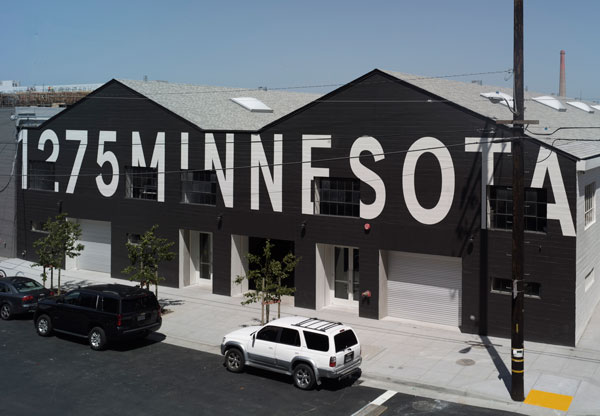In San Francisco’s downtown gallery district, one building, 49 Geary Street, once held the greatest concentration of the best galleries—over 20 on five floors. With Gallery Paule Anglim across the street at 14 Geary, and a half-dozen more at 77 Geary just down the street, this one block had anchored the whole SF gallery scene. As tech boomed, Bay Area real estate became red hot. For artists and gallerists, the skyrocketing market spelled trouble. As rents soared, morale ebbed, and galleries began dropping like flies.

Catharine Clark at her 248 Utah Street gallery, in the DoReMi arts district, courtesy Catharine Clark Gallery
To top it off, in 2013 SFMOMA was darkening its doors for three years of remodeling. Leaving downtown, gallerists Catharine Clark and Brian Gross joined Todd Hosfelt in adjacent buildings on Utah Street in the Potrero Hill neighborhood, historically a design district. Jack Fischer and George Lawson soon followed suit, becoming neighbors on Potrero Street around the corner. The galleries’ expansive new spaces and the excitement they stirred gave the arts community a temporary shot in the arm. But things downtown got progressively worse—rents in 49 Geary became astronomical—and gallerists in 77 Geary were told unceremoniously that they were no longer welcome. Many decided to call it quits, go into private consulting, or move out of the area. Artists, too, were finding San Francisco inhospitable and moving across the bay to Oakland, or farther.

Andy and Deborah Rappaport
“There was a lot of negativity,” Clark reflected. “I sat in my office with Andy and Deborah Rappaport [retired venture capitalists, collectors and arts supporters] and we asked, ‘What can we do to stop the attrition?’ It became clear that what people needed most was space for galleries and studios, with affordable rents.” The Rappaports wasted no time finding buildings on Minnesota Street in the rather nondescript industrial area of southeastern SF known as The Dogpatch, with plans to lease out space at well-below market rates. At a brainstorming meeting, a name for the new arts district was coined. “MiPoDo” lost out to the mellifluous “DoReMi:” “Do” for Dogpatch, “Re” for Potrero, and “Mi” for the Mission—long home to a number of well-established alternative spaces such as Southern Exposure, The Lab, Gallería de la Raza and Intersection for the Arts.
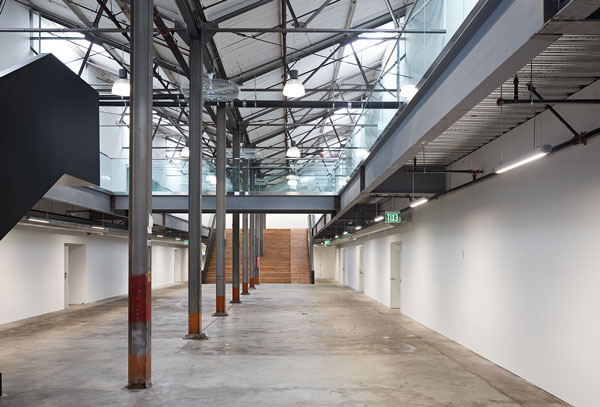
Interior, courtesy Minnesota Street Project
From initial discussion to the public opening of the Minnesota Street Project, a brief span of two years has elapsed. The day before the gala opening, construction was still very much in progress. Orange cones and yellow caution tape outlined a lengthy stretch of freshly-laid black asphalt, while workers were occupied installing the front doors at 1275 Minnesota. The remodeled space, designed by architect Mark Jensen, is minimal. Its contemporary aesthetic highlights exposed trusses and support beams, juxtaposing these structural features with streamlined staircases—and an entirely new second-story mezzanine. The project houses 10 permanent galleries signed for leases of three years or more. There are also three temporary galleries and a nonprofit space, the SF Arts Education Project. A high-tech multimedia room will be shared, along with shipping and packing facilities, a kitchen, showers and extra storage. A large vacant space, immediately to the right of the entrance, is earmarked for a restaurant, to be run by celebrated chef Daniel Patterson.
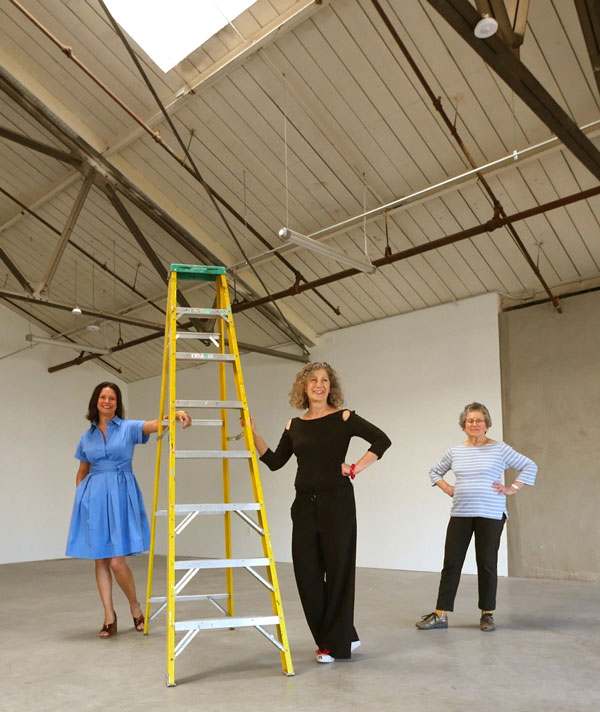
Jenny Baie, Trish and Rena Bransten, photo by David Bransten
Anglim Gilbert Gallery, which will also retain its downtown location, occupies one of the largest spaces on the mezzanine. Rena Bransten, delighted with her new gallery, called it “the prettiest space we’ve ever been in,” adding “it’s good for San Francisco, it’s good for everyone!” Nancy Toomey, Eleanor Harwood, and Jack Fischer are also on the second floor. With a small space here supplementing his Potrero location, Fischer is particularly happy with the “collegial atmosphere—fostered largely by the altruism brought to this by the Rappaports.”
On the lower level, Casemore Kirkeby combines the talents of Stefan Kirkeby and Julie Casemore. Andrew McClintock’s Ever Gold [Projects] has relocated here from its spot in the gritty Tenderloin. Themes+Projects is the new incarnation of Modernbook, a gallery formerly in 49 Geary for five years. One of the smallest spaces, Bass & Reiner, is run by four recent SFAI graduates. Et al. etc. offers expanded programming from Et al., the Chinatown gallery located in the basement of Union Cleaners.
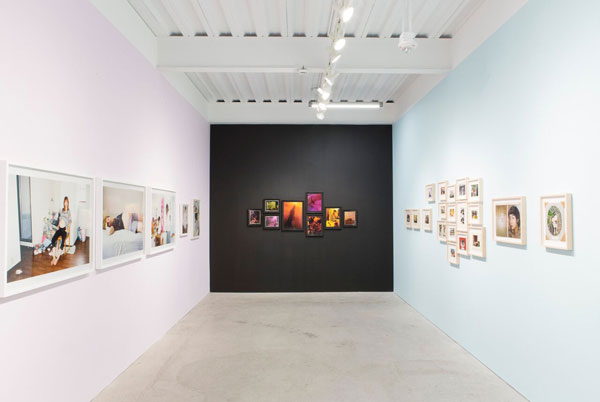
Paul Wackers: Slow Wave, Courtesy of Eleanor Harwood Gallery
Deborah Rappaport said, “It is mind-blowing actually. It doesn’t feel real to me yet.” She added that looking ahead, “the studio building, a block up the street on the corner of 25th, will open, along with the nearby building that will provide art storage services, 100,000 cubic feet of fully air-conditioned storage.” One might well wonder how they were able to accomplish so much so quickly, and if everything was indeed smooth sailing. Andy Rappaport observed that “everyone was immediately enthusiastic.” Regarding obstacles, he said, “We try to figure out how to get ‘no’ to yes. Our modus operandi is you have to show us why not.”
After all the anticipation and frenzied preparations, an impressive line snaked down and around the block for the Minnesota Street gala opening. The large atrium and wide hallways emerged as spaces to see and be seen, while the view across the mezzanine, as well as down the stairs/seats, and to the lower floor, was exhilarating—especially when the crowd poured in, activating all the spaces with its energetic buzz.
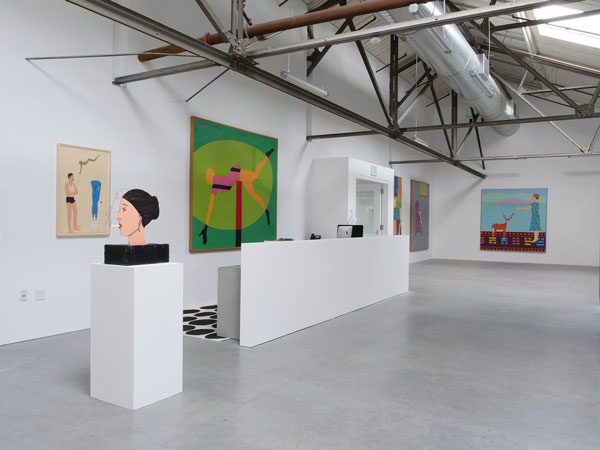
New Material, Courtesy of Casemore Kirkeby.
Now, as the dust begins to settle, it will be interesting to see the actual impact of this shift. At the moment, all is shining potential. There may be nostalgia for the days when it was possible to visit most of the major SF galleries in a single afternoon, but it’s hard to argue with the blossoming of many new galleries, along with the relocated favorites. With SFMOMA reopening in a splashy, vastly enlarged space, the mood has noticeably lifted. Yerba Buena will certainly welcome as well new neighbors John Berggruen and Gagosian galleries.
One wonders if other philanthropists will find inspiration in the Rappaport’s example. With the cards long stacked against them, it’s certainly encouraging to see art lovers in San Francisco feeling optimistic once again. Minnesota Street Project may in some respects be a stopgap measure, but for a frustrated arts community this leap of faith clearly exemplifies the resilience and creativity of a vibrant San Francisco art scene that is here to stay.

